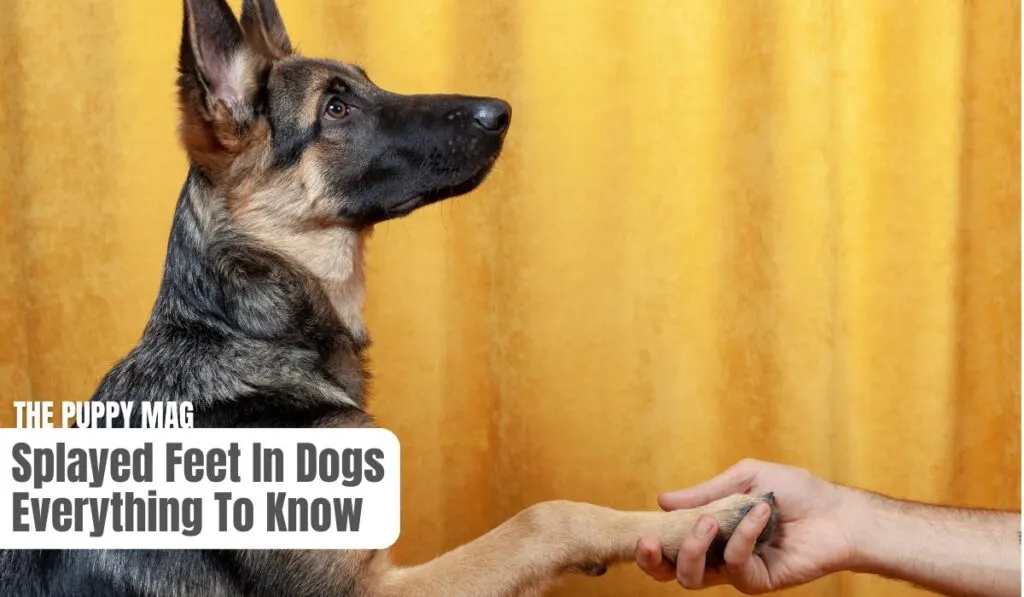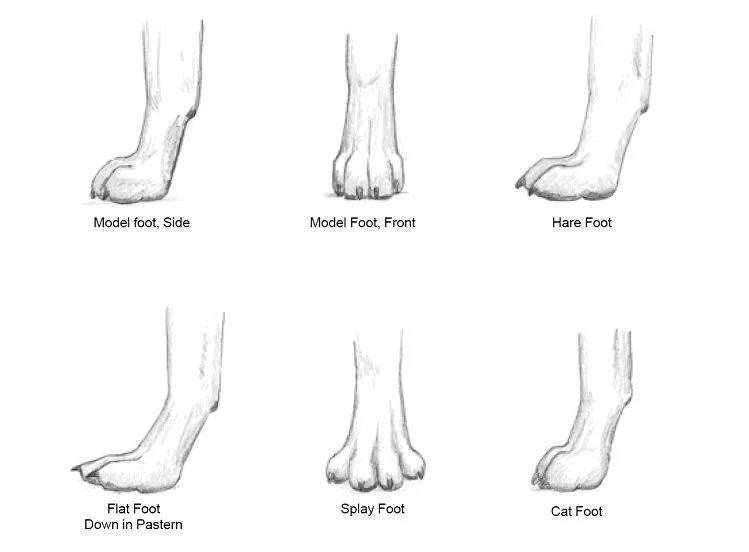If you’ve ever noticed your dog’s paws splaying out to the sides when they walk, it may be a sign of splayed feet, a common condition that can be treated with proper care.
This blog post aims to provide a complete guide on splayed feet in dogs, including the causes, symptoms, and available treatment options. We’ll also address some frequently asked questions about this condition.
By the end of this article, you’ll have a comprehensive understanding of splayed feet in dogs and how to manage it effectively to ensure your furry companion’s well-being.

What is splayed feet in dogs
Splayed feet, also known as flat feet or hyperpronation, is a common condition in dogs where the paws flatten out and spread apart, causing the feet to lose their arch and shape.
This condition can affect any breed or age of dog, but it is more commonly seen in large breeds.
Splayed feet usually causes quite a bit of discomfort and pain for most dogs, so it’s something owners should definitely take seriously and have looked at.
Fortunately in most cases, various forms of treatment will be available to help the dog recover.
The following diagram shows a few different paw variations. Here you can see what splayed feet really look like.

What you must know: Ingrown Dog Whisker
The difference between splayed feet and flat foot in dogs
Splayed feet and flat feet are two different conditions that can affect dogs’ paws and limbs, yet are often mistaken for one another.
Splayed feet refer to a condition where the toes on a dog’s paw splay outwards, away from each other, rather than remaining tightly together. This can cause the dog to have difficulty walking or running, and it can be quite painful. Splayed feet are often caused by a genetic predisposition or an injury to the paw.
On the other hand, flat feet are a condition where a dog’s paws lack proper arch support, causing the paws to lay flat on the ground. This can cause the dog to walk with a rolling or wobbling gait, and it may lead to joint pain or injury over time. Flat feet can be caused by a variety of factors, including genetics, age, obesity, or injury.
While splayed feet and flat feet can both affect a dog’s mobility and quality of life, they are distinct conditions with different causes and treatments.
Main causes of splayed feet in dogs
Splayed feet in dogs can be caused by a variety of factors, including genetics, poor nutrition, injury, or developmental issues.
Genetics
Some breeds are more prone to splayed feet due to their genetics. Labrador Retrievers, for example, are known to have flatter feet.
This is because the breed was originally bred to retrieve game from water, and the flatter feet help them swim better.
Other breeds that may be predisposed to splayed feet include Golden Retrievers, Great Danes, and Bernese Mountain Dogs.
Poor Nutrition
Puppies with poor nutrition during their growth period can also develop splayed feet. Proper nutrition during puppyhood is crucial for the development of healthy bones and joints.
A diet that is deficient in essential nutrients, such as calcium and vitamin D, can lead to weak bones and joints, which may result in splayed feet.
Injury or Trauma
Injury or trauma to the paws can also lead to splayed feet. Puppies who are allowed to play on rough surfaces or who experience a trauma to their paws may develop splayed feet.
In addition, older dogs who suffer from arthritis or other joint problems may be more prone to developing splayed feet.
Developmental Issues
Finally, some developmental issues can also cause splayed feet in dogs. For example, if a puppy is kept in a crate that is too small for them or if they are forced to stand or walk on an unstable surface, this can lead to splayed feet.
Popular: Why does my puppy have a pink nose (solved)
The Puppy Mag Favorites
👍 Set & Forget Interactive Dog Toy
Perfect for mental stimulation.
😍 The No.1 Low Calorie Dog Treat
Perfect for healthy treat-giving.
Symptoms of splayed feet in dogs
Of course, the most obvious symptom is to see your dog’s feet prominently splayed outwards (or facing opposite directions). Still, there a few other signs and symptoms that owners should look out for.
Dogs with splayed feet may exhibit extra symptoms, including:
- Difficulty walking or standing
- Splayed or flattened paw pads
- Excessive wear on the paw pads
- Pain or discomfort in the paws
- Changes in gait or posture
It is important to note that not all dogs with splayed feet will exhibit these symptoms. Some dogs may have splayed feet but still be able to walk and run without any difficulty.
This doesn’t mean that their splayed feet shouldn’t be looked into. Even if a dog seems to be handling their splayed feet, it still needs to be checked out by a vet.
Treatment for splayed feet in dogs
The treatment for splayed feet in dogs will depend on the underlying cause of the condition.
Orthopedic Shoes or Braces
In some cases, orthopedic shoes or braces may be recommended to provide support and correct the position of the paws. These devices can help alleviate pain and discomfort and prevent further damage to the paws.
Surgery
In more severe cases, surgery may be necessary to correct the structure of the paws and alleviate discomfort. This may involve realigning the bones in the paw or inserting pins or screws to stabilize the joints.
Physical Therapy
Physical therapy may also be recommended to help dogs with splayed feet. This may involve exercises to strengthen the muscles and improve range of motion in the affected paw or paws.
Preventing splayed feet in dogs
While splayed feet may be caused by genetic factors, there are steps that can be taken to prevent the condition from developing or worsening.
Proper Nutrition
Providing a balanced and nutrient-rich diet during your dog’s growth period can help ensure proper bone and joint development. A diet that is high in calcium and vitamin D can help promote healthy bones and joints.
Regular Exercise
Regular exercise can also promote healthy paw structure and strengthen the muscles and ligaments in the paws.
However, it is important to provide exercise that is appropriate for your dog’s age, breed, and health status.
High-impact activities, such as jumping or running on hard surfaces, should be avoided for dogs who are at risk of developing splayed feet.
Proper Foot Care
Proper foot care can also help prevent splayed feet. This may include trimming the nails regularly, keeping the paw pads clean and dry, and avoiding exposure to rough surfaces that can cause injury to the paws.
Trending: Why does my dog’s ears flip inside out? (surprising reasons)
When to see a vet
Owners should seek help from their veterinarian as soon as they notice any signs or symptoms of splayed feet in their dog, such as splayed or misaligned paws, difficulty walking or running, or pain and discomfort.
Early diagnosis and treatment can prevent the condition from worsening and potentially causing long-term damage to the dog’s mobility and quality of life.
Additionally, if an owner suspects that their dog may be at risk of developing splayed feet due to breed or age-related factors, they should consult with their vet for advice on preventative measures and appropriate care.
Conclusion
Splayed feet in dogs can be a painful and debilitating condition, but with proper care and treatment, dogs with this condition can live happy and healthy lives.
If you suspect that your dog may have splayed feet, it is important to consult with a veterinarian who can provide a diagnosis and recommend the appropriate treatment plan.
By providing your dog with proper nutrition, exercise, and foot care, you can help prevent splayed feet from developing or worsening.
